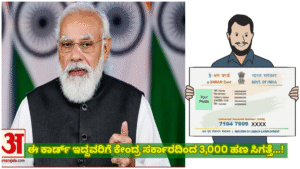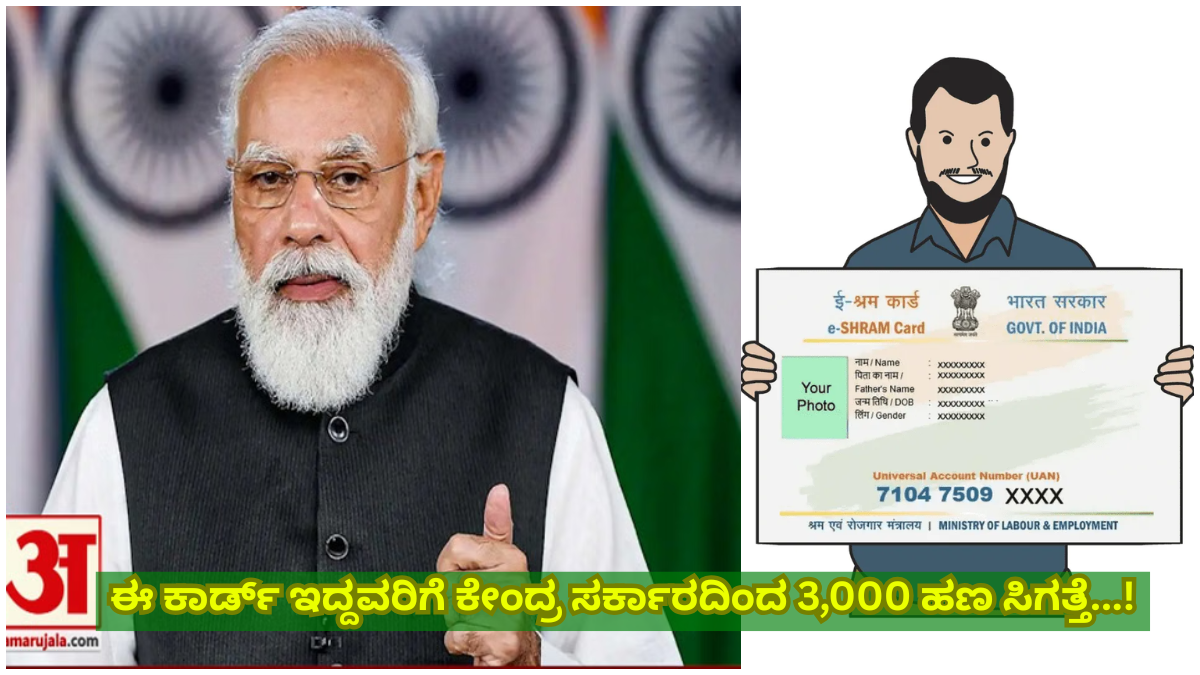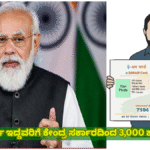India is home to millions of hardworking people who earn their living through daily wages, manual labor, or small-scale jobs. These individuals form the backbone of the Indian economy but often remain outside the formal employment system. They work tirelessly in construction sites, farms, streets, households, factories, and markets — yet most of them lack social security, stable income, or access to government benefits. Such workers are known as unorganized sector workers.

To recognize, register, and support these workers, the Government of India launched the E-Shram Card Scheme, a major initiative aimed at bringing unorganized laborers under one national database. This scheme not only provides a unique identity to each worker but also ensures that government welfare benefits reach them directly and efficiently.
Understanding the E-Shram Card
The E-Shram Card is a special identity card issued by the Ministry of Labour and Employment, Government of India. It serves as a digital record of unorganized workers across the country and acts as a bridge between workers and government welfare programs.
Each registered worker receives a 12-digit Universal Account Number (UAN), which remains valid throughout India. Once a person is registered under the E-Shram portal, they do not need to reapply even if they move to another state or change their type of work. The UAN helps in maintaining continuity and tracking the worker’s employment history.
The card also links the worker’s Aadhaar and bank account information, allowing direct benefit transfer (DBT) of government funds without middlemen or delays.
Who Can Register for the E-Shram Card?
The E-Shram Card is designed exclusively for those working in the unorganized sector, meaning workers who are not covered under EPFO (Employees’ Provident Fund Organisation) or ESIC (Employees’ State Insurance Corporation).
Any Indian citizen aged between 16 and 59 years who works in the informal economy can register. The scheme covers a wide range of occupations, including but not limited to:
- Construction workers – masons, plumbers, electricians, painters, etc.
- Drivers – auto, cab, truck, and delivery vehicle drivers.
- Agricultural laborers – farmworkers, harvesters, or landless laborers.
- Street vendors and hawkers – those who sell goods on roadsides or markets.
- Domestic workers – household helpers, cleaners, cooks, and caretakers.
- Fishermen and women – those engaged in fishing and fish processing activities.
- Tailors, artisans, and handloom workers – small-scale or home-based craftsmen.
- Rickshaw pullers, loaders, and porters.
- Small shop workers or self-employed individuals.
Essentially, anyone who earns daily or seasonal income without a permanent job or written contract can apply for the E-Shram Card.
Documents Required for Registration
Registering for the E-Shram Card is a simple process, but applicants need to keep the following documents ready:
- Aadhaar Card – serves as proof of identity and address.
- Bank Account Details – for receiving government benefits directly.
- Mobile Number Linked with Aadhaar – for OTP verification and future communication.
- Occupation Details – type of work or category of labor performed.
How to Register for the E-Shram Card
There are two convenient ways to register for the E-Shram Card:
1. Self-Registration (Online Method)
Workers who can access the internet and have a smartphone can register on their own:
- Visit the official E-Shram portal: https://eshram.gov.in
- Click on “Register on E-Shram.”
- Enter your Aadhaar-linked mobile number and complete OTP verification.
- Fill in your personal details, employment category, and bank information.
- Once submitted, your E-Shram Card will be generated instantly and can be downloaded or printed.
2. Registration through Common Service Centres (CSC)
For those who do not have internet access, nearby CSC centers provide free or assisted registration.
The operator will collect your details, verify your documents, and issue your E-Shram Card.
This service ensures that even workers from rural areas can easily enroll without any technical difficulty.
Major Benefits of the E-Shram Card
The E-Shram Card offers multiple advantages to unorganized workers. Some benefits are immediate, while others will be introduced gradually as more welfare programs are integrated into the system.
1. Free Accident Insurance Coverage
All registered workers automatically receive Pradhan Mantri Suraksha Bima Yojana (PMSBY) coverage worth:
- ₹2,00,000 in case of accidental death or permanent disability.
- ₹1,00,000 in case of partial disability.
This insurance is provided free of cost and is valid as long as the worker’s E-Shram registration remains active.
2. Direct Access to Government Welfare Schemes
With the help of the centralized database, the government can directly identify beneficiaries and deliver scheme benefits such as financial aid, skill training, or employment support.
Workers no longer need to apply separately for multiple programs. Their UAN ensures they automatically qualify for schemes like PM-SYM (Pension Yojana), PM-JAY (Health Scheme), or PM-KISAN (for eligible farmers).
3. Portability Across India
The E-Shram Card is valid nationwide, meaning workers can move from one state to another without losing benefits.
For instance, a laborer from Karnataka can migrate to Delhi or Maharashtra for work, and still continue receiving support under the same UAN.
4. Direct Bank Transfers (DBT)
Whenever the government announces financial assistance — for example, during emergencies, pandemics, or welfare campaigns — the funds are directly credited to the worker’s registered bank account linked with the E-Shram Card.
This eliminates corruption, delays, and the need for middlemen.
5. Inclusion in Future Welfare Programs
The E-Shram platform is designed as a long-term system that will later integrate with additional social security programs such as:
- Pension schemes for old-age support
- Health insurance and medical benefits
- Maternity and child care assistance
- Education support for children of workers
- Skill development and employment exchange services
The idea is to build a comprehensive welfare ecosystem where every worker, regardless of their location or occupation, enjoys basic social protection.
Why the E-Shram Scheme Is So Important
More than 90% of India’s workforce is employed in the unorganized sector.
Despite their huge contribution to the economy, they often live on the margins of society — without insurance, pensions, or job security.
The COVID-19 pandemic exposed this vulnerability dramatically.
When lockdowns halted work, millions of laborers lost their livelihoods overnight. The government faced difficulty reaching them with aid because there was no centralized database of unorganized workers.
The E-Shram initiative was launched to solve this very problem — to create a single national registry that contains detailed information about every worker in the informal economy.
This database allows the government to:
- Identify workers by occupation, skill level, and location.
- Plan policies more effectively.
- Deliver emergency relief instantly.
- Ensure inclusion of migrant and seasonal laborers in welfare programs.
In short, it is a step toward social and economic justice for India’s most vulnerable workforce.
Impact in Karnataka
Karnataka, being one of India’s rapidly developing states, has a large population of daily-wage and informal sector workers. From construction sites in Bengaluru to fishing communities along the coast and agricultural laborers in rural districts, unorganized workers play a key role in the state’s economy.
The Government of Karnataka, in partnership with the central government, has been actively promoting E-Shram registration through awareness drives, labor departments, and CSC centers.
Local officials and NGOs help workers understand the benefits and assist them in enrolling online or offline.
As of recent updates, lakhs of unorganized workers in Karnataka have already registered under the E-Shram portal and begun receiving benefits like insurance coverage and financial aid.
Steps After Registration
Once a worker has successfully registered, they should:
- Download and print the E-Shram Card – keep it safe for future reference.
- Check the accuracy of personal and bank details.
- Update the information regularly if they change jobs, addresses, or contact numbers.
- Renew PMSBY insurance annually (usually auto-renewed through linked bank accounts).
- Stay informed about new schemes launched under the E-Shram initiative.
Government Vision Behind the E-Shram Initiative
The E-Shram Yojana is part of India’s broader vision of “Digital Inclusion and Social Security for All.”
The key objectives are:
- To create a national database of unorganized workers.
- To provide universal access to welfare benefits.
- To reduce income inequality and economic vulnerability.
- To bring informal workers under formal recognition.
- To promote financial inclusion through bank-linked benefits.
- To support policy planning and labor reforms based on real data.
By integrating with other government platforms like the National Career Service (NCS) and Skill India Mission, E-Shram also opens new doors for employment and skill development.
Challenges and the Way Forward
While the E-Shram Scheme is an ambitious and progressive step, it still faces several challenges:
- Awareness Gap: Many workers, especially in remote villages, are unaware of the scheme.
- Digital Divide: Not everyone has access to smartphones or the internet to register online.
- Data Accuracy: Keeping worker information updated is a constant task.
- Coordination Between States: Migrant workers often move frequently, making tracking difficult.
To overcome these issues, continuous awareness campaigns, local language outreach, and mobile registration camps are being organized. The government also plans to integrate E-Shram data with state labor departments, EPFO, and ESIC systems for smoother service delivery.
Conclusion
The E-Shram Card Scheme represents a historic milestone in India’s labor welfare journey.
It is not merely a card — it is a symbol of recognition, dignity, and inclusion for millions of unorganized workers who contribute silently to the nation’s growth every day.
By registering for the E-Shram Card, workers gain access to insurance, social security, and a host of welfare schemes that can safeguard their future.
For the government, it serves as a foundation to build a fairer, more inclusive economic system where no worker is left behind.











